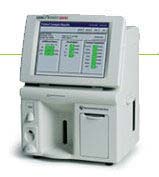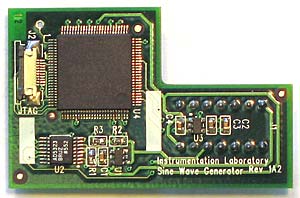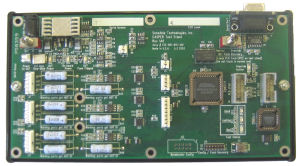PROJECTS
PDF Synthesized Sine Wave Generator
System Overview
 The original system used a Fairchild ML2036 programmable sine wave generator. The chip was based on a Numerically Controlled Oscillator (NCO) that fed a sinewave lookup table to an on-chip Digital to Analog (D/A) Converter. Several dedicated outputs generated reference frequency outputs for use elsewhere in the system. Bolton duplicated this functionality in an Intel/Altera MAX-II series 240-macrocell Programmable Logic Device (PLD), and used an external 10-bit serial D/A and op-amp to create the bipolar analog output. A low-power linear regulator generated the 3.3V logic supply. The PLD incorporated a 512-entry sine wave lookup table constructed out of a simpler 128-entry quarter-wave sine wave lookup table and "unfolding" logic. The PLD was synthesized and simulated in Altera's Quartus tool set and the first code set programmed into the PLD worked without requiring changes. The total board size was 1.3" x 2.1". (including the cut-out region).
The original system used a Fairchild ML2036 programmable sine wave generator. The chip was based on a Numerically Controlled Oscillator (NCO) that fed a sinewave lookup table to an on-chip Digital to Analog (D/A) Converter. Several dedicated outputs generated reference frequency outputs for use elsewhere in the system. Bolton duplicated this functionality in an Intel/Altera MAX-II series 240-macrocell Programmable Logic Device (PLD), and used an external 10-bit serial D/A and op-amp to create the bipolar analog output. A low-power linear regulator generated the 3.3V logic supply. The PLD incorporated a 512-entry sine wave lookup table constructed out of a simpler 128-entry quarter-wave sine wave lookup table and "unfolding" logic. The PLD was synthesized and simulated in Altera's Quartus tool set and the first code set programmed into the PLD worked without requiring changes. The total board size was 1.3" x 2.1". (including the cut-out region).
Project Scope
Bolton Engineering wrote the specification, designed the schematics, wrote and simulated the PLD code, designed the 4-layer circuit board, wrote the PLD code, debugged the system, and delivered twelve working prototypes.

The Instrumentation Laboratory product incorporated a sole-sourced component that had become obsolete. Purchasing had located sufficient parts to last for the product lifetime, but an unexpected contract manufacturer shortage suddenly left them searching for parts. The production line would be halted if a fix could not be implemented quickly. Instrumentation Laboratory hired Bolton Engineering to develop a small plug-in circuit board to take the place of the obsoleted component. In less than two weeks, Bolton Engineering delivered fully functional boards that plugged into the original chip location, duplicated the chip functionality, and successfully passed all tests.













































